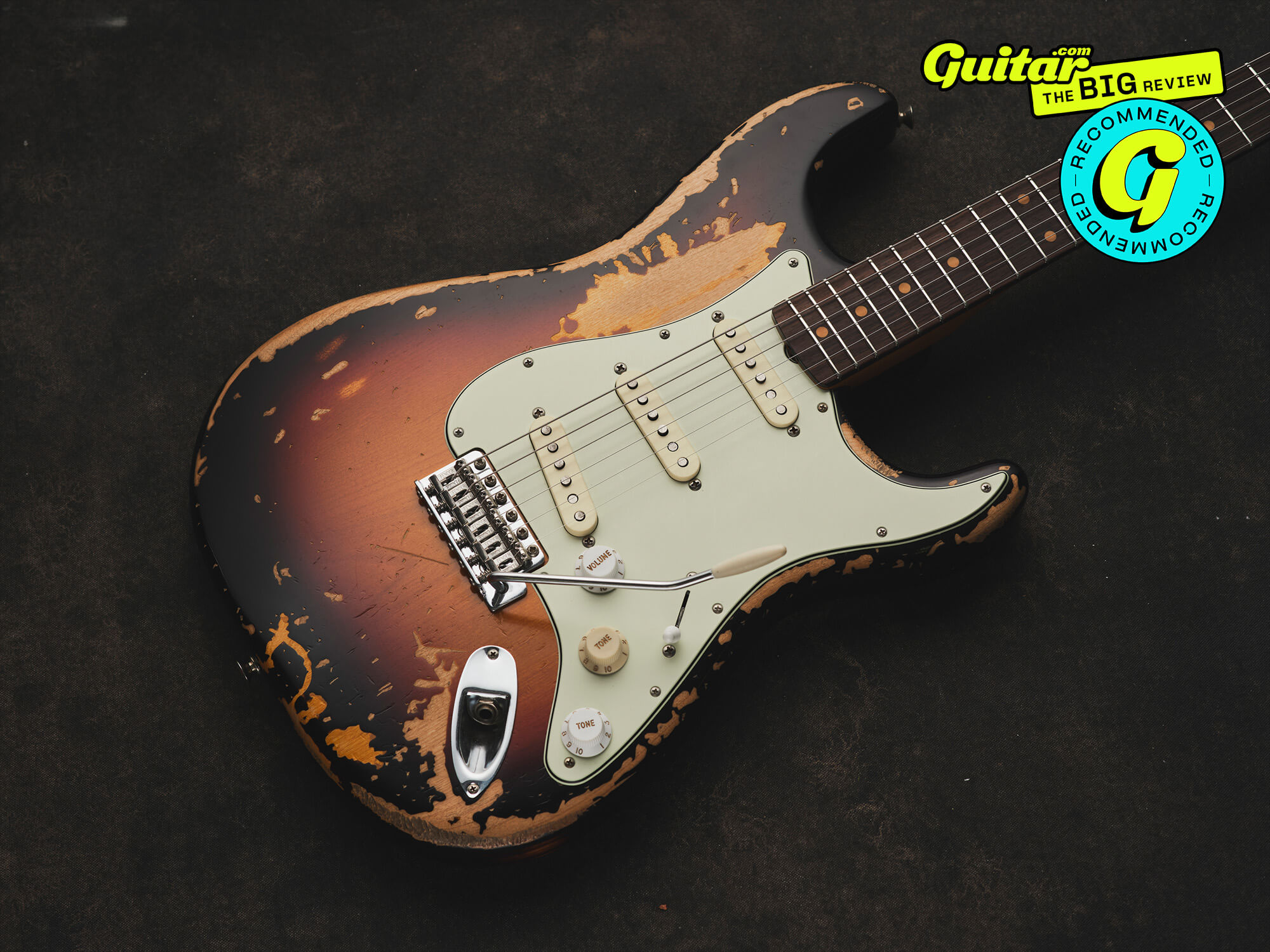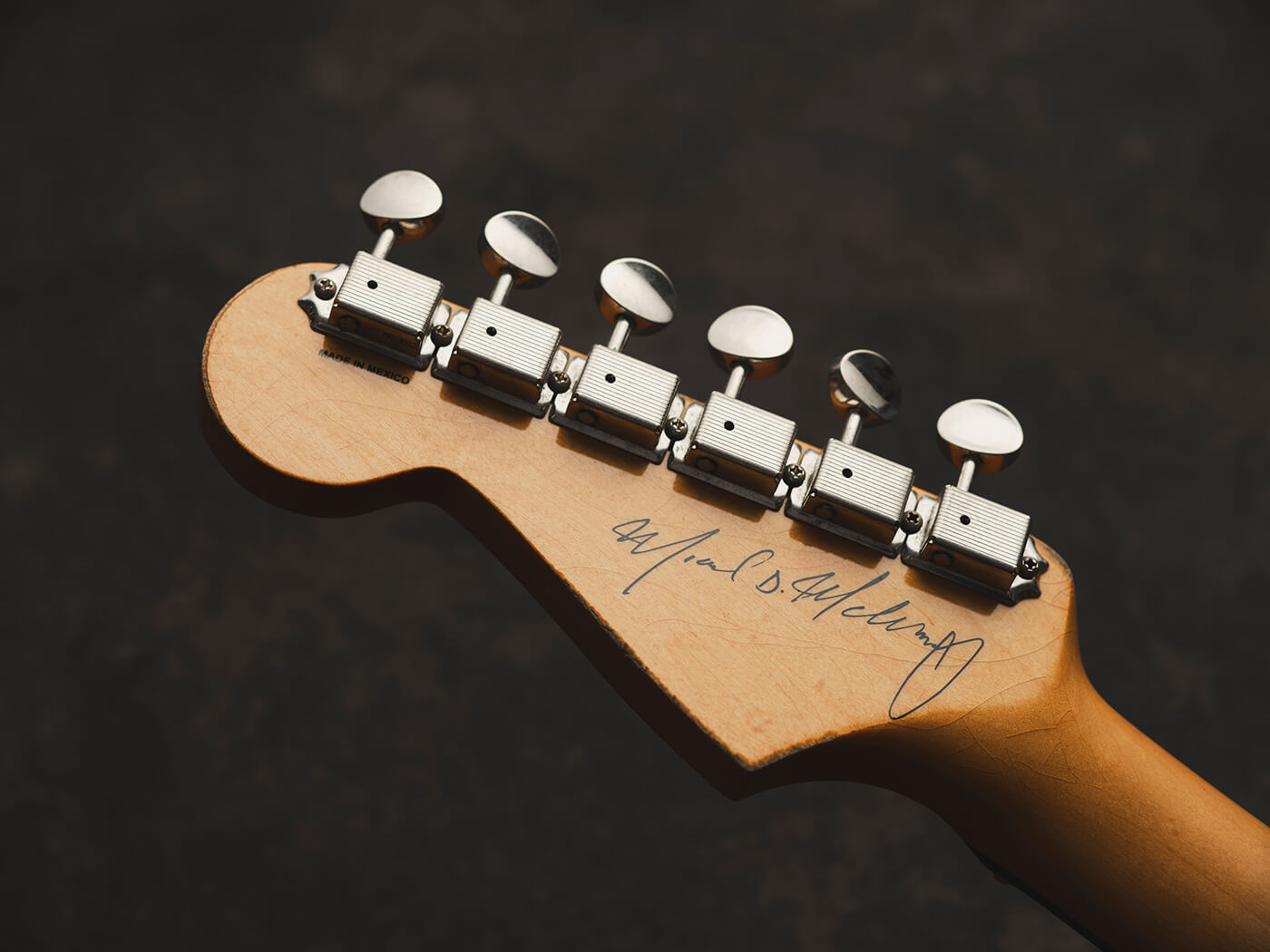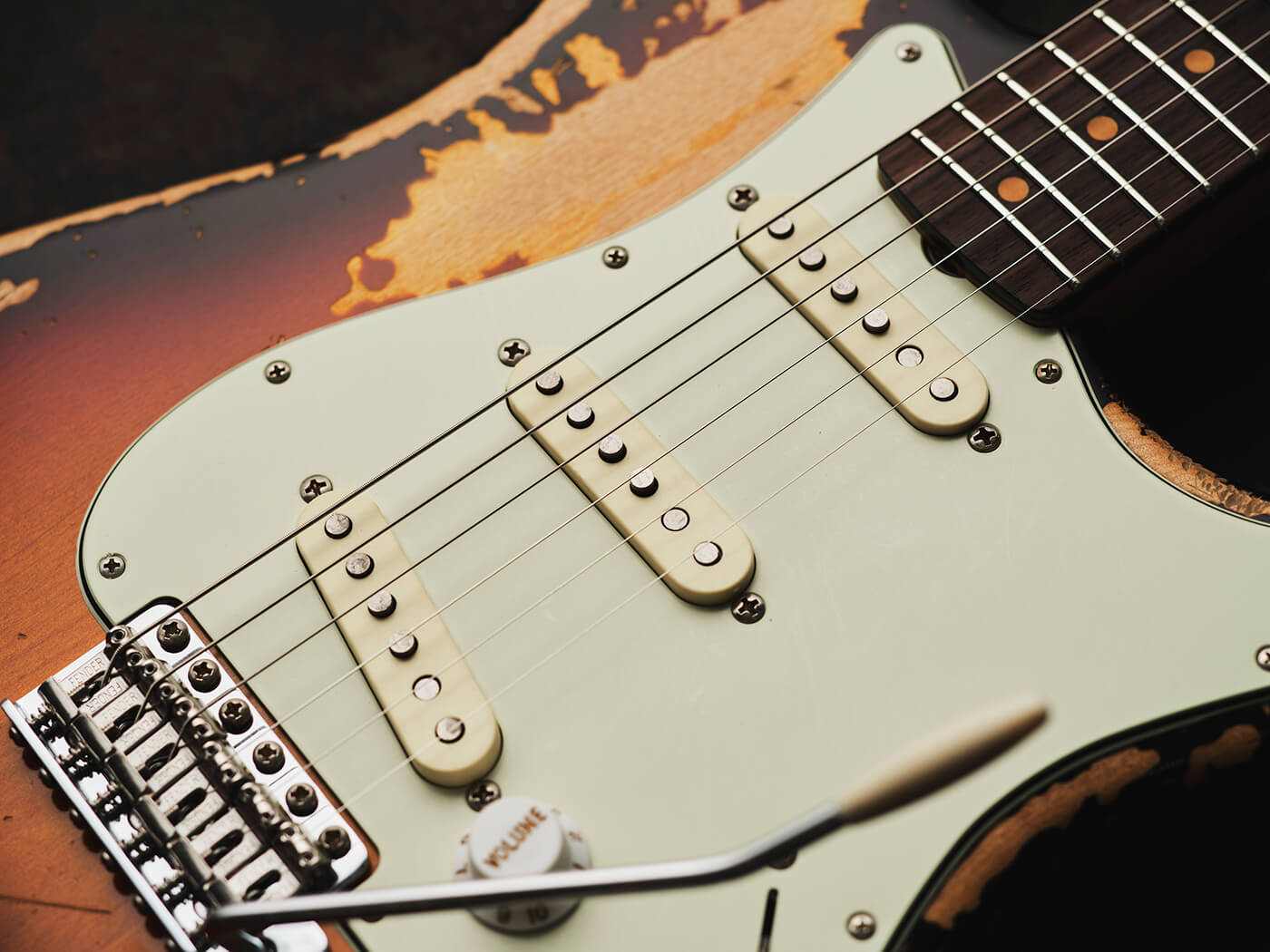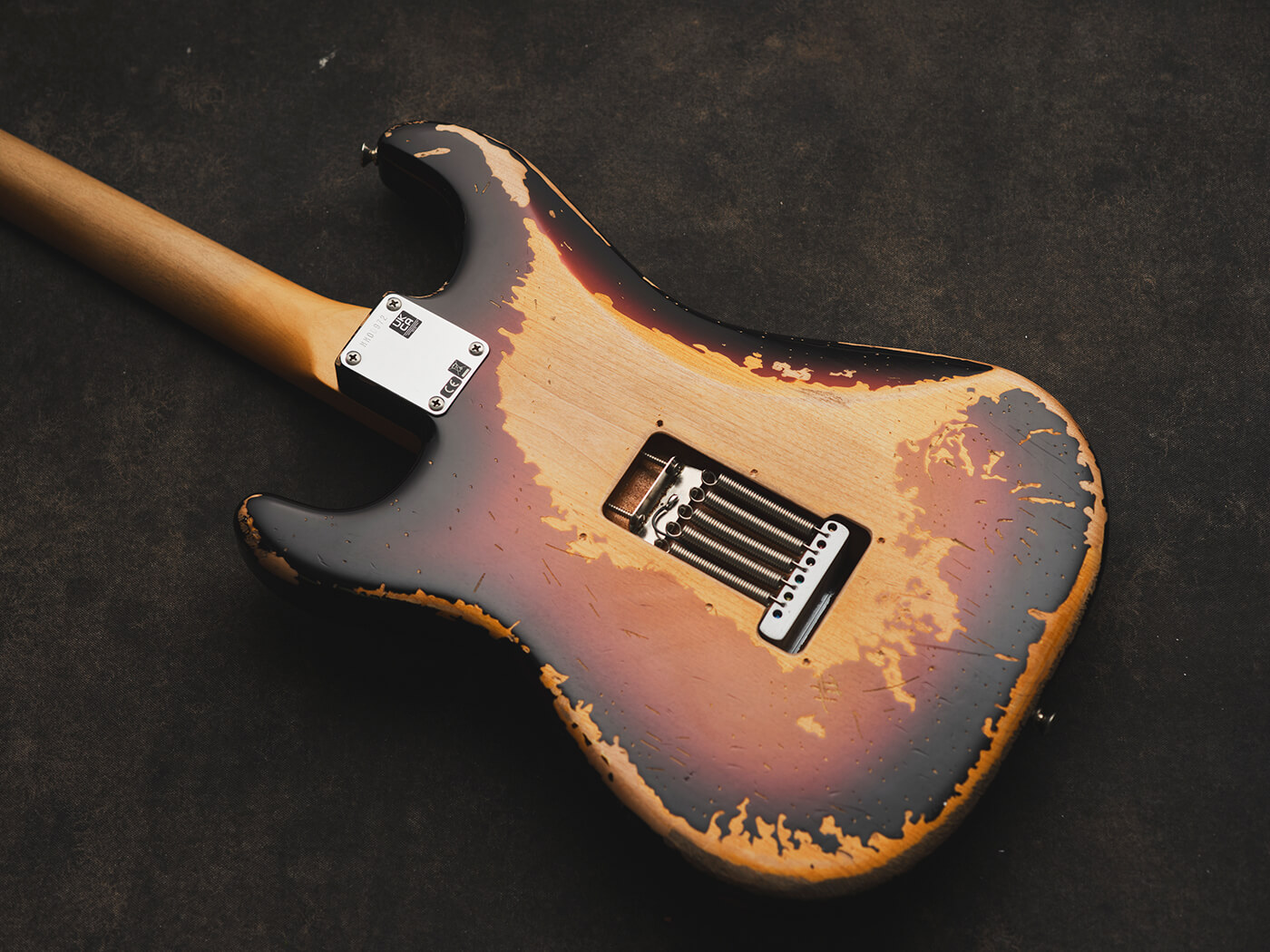Fender Mike McCready Stratocaster – the ultimate accessible relic Strat?
A ding-for-ding recreation of the Pearl Jam man’s battered 1960 Strat makes this the most expensive Mexican guitar Fender currently produces – but is it worth the extra outlay?

Fender Mike McCready Stratocaster. Image: Adam Gasson
Review Overview
Our rating
9
Our verdict
$1,899/£1,649, fender.com
About a decade ago, I became the temporary steward of one of Fender’s very first attempts to bring relic’ing to the masses in the shape of the Mexican-made Road Worn Jazzmaster. The original Road Worn guitars had a few scuffs, chips and dinks, but the sense was that Fender felt that less was probably more when it came to artificial ageing – the more extreme the wear you did, the more fake it looked as other brands who attempted to follow suit would demonstrate it.
A lot can change in a decade, however, as evidenced by the guitar I’m holding today – Fender’s more affordable take on one of the most striking Custom Shop instruments of recent years, the Mike McCready 1960 Stratocaster. The Pearl Jam man’s original guitar is a wonderfully beaten-up thing with a huge amount of wear and tear all over that makes it a truly unique instrument. Replicating all of that is a big part of the reason why the original limited-run Custom Shop guitar would set you back the thick end of 15 grand, but now we have a guitar that, from a distance at least, looks very similar to the original but costs a little over a tenth of the price. So what gives?

How does Fender relic the Mike McCready Strat?
And when you pull the guitar out of its brown G&G hard case, two seemingly contradictory things strike you. Firstly, this is nowhere near the almost-real levels of relic’ing seen on the Custom Shop guitar, but at the same time, it’s a remarkable testament to how far Fender’s mass-production factory ageing techniques have come.
So let’s get the important stuff out of the way out of the gate – the finish on the guitar is bona fide nitrocellulose lacquer, and it has been buffed to have a satin and slightly worn-in feel, but up close it’s very obviously a new finish and there’s no attempt at the sort of lacquer checking that would be present on a real guitar of this age that was this beaten up. Equally, there are a few slightly artless bits of wear and tear where it very much feels like they’ve been sanded with a template, and the less said about the fake screw-holes on the back for the (nonexistent) tremolo cover the better.
But honestly? That’s about it. Compared to previous Road Worn instruments, real care has been taken in making the transition between bare and lacquered finish feel smooth, the bare wood underneath has been stained and dirtied in a way that doesn’t feel so uniform and looks more authentic as a result, while the hardware and plastics feel convincingly faded, grubby and worn in. The neck is the crowning achievement however. Here you’ll find a beautifully worn maple that genuinely feels like it’s been played rather than merely sanded or buffed to a satin finish. The rosewood board edges are nicely rolled and the nut and dots have a nice tobacco-stained patina to them. The headstock might be the most impressive bit of relic’ing on the whole thing, with some nicely executed chips and dings and yes, the appearance of some bona fide cracking and checking to the lacquer. It’s a shame they couldn’t do it to the whole guitar, but it’s a lovely job.
Beyond the relic stuff, well it’s still a Mexican Strat so you get the standard 9.5” radius board but paired with a Slim C neck designed to replicate McCready’s 1960 original. You also get a trio of signature pickups tailored to the ear of the man himself, plus a treble bleed circuit to tame that bridge pickup’s most cutting tendencies – let’s dive in.

What does the Fender Mike McCready Strat play like?
If you’ve played a lot of old Strats, there’s something weirdly familiar yet not about a guitar that feels this old and worn-in that doesn’t have a 7.25” radius, but you soon forget that within a couple of minutes of sitting down because the experience is just so comfortable and enjoyable.
I have to take my metaphorical hat off to whoever it is at Fender’s Ensenda factory that worked on this neck because it’s an unabashed joy to play – worn in to just the right level to make it effortlessly playable all the way up the fretboard, with some beautifully rolled edges enhancing the positive tactile experience. And the Slim C profile is a real antidote to the baseball bats you sometimes get on guitars that are trying to be old.
The vintage-style tuners are a lot more stable and secure than most vintage units would be in these circumstances, and that stability is helped by the fact that the trem is very much set up for momentary wobbles. It’s shipped set up flat to the body and a quick peek around back shows that we’ve got all five springs in use in the vibrato cavity. Obviously this is an easy enough change if you prefer your trem to float and have a little more give, but just be aware that you’re not going to be Jeff Beck-ing things straight out of the box.

Does the Fender Mike McCready Strat sound good?
Even before plugging in there’s a lively resonance to this guitar that could just be luck of the drawer, but the romantic in me likes to think that it’s a combination of the nitro and the heavy wear that’s giving the wood more freedom to resonate – regardless, it’s always a good sign when a guitar sounds great acoustically.
Plugging in and even with high expectations I’m taken aback – this is probably the best sounding Mexican-made Strat I’ve ever experienced, and it could give some of Fender’s USA guitars a good run for their money too.
Much of the credit for this has to go to McCready, who insisted that his signature pickups were as close as humanly possible to the sound of his 1960 model, and whatever special mojo is going on here, Fender needs to copy it and stick them in the next generation of Vintera Strats because everyone is going to want a piece of these.
It’s trite to say that it sounds just like you’d want a good vintage Strat to sound – which it does – but let’s delve into what that really means. The neck is warm, woody and squashy, while there’s a powerful but cavernous quality to the middle pickup that acts as a wonderful foil to the other pickups in positions two and four. The bridge might be the star of the show however, with the treble-bleed circuit working in concert with the pickup itself to create a pickup of rare girth, replacing any of the shrillness that you often get with Strat bridge with a chewy midrange punch. Layering on the drive and turning the volume up only accentuates what a fantastic-sounding pickup this is – it might be the most usable and great-sounding Strat bridge pickup I’ve ever played.
Is the Fender Mike McCready Strat worth it?
Usually with a signature model, much of the worth of an instrument depends on how much you like the artist in question, and if you’re a Pearl Jam fan looking for a Strat to emulate McCready’s signature tones just stop reading here and go buy the damn thing – you won’t find a guitar that gets you closer in look, feel or tone for twice the price.
For the rest of us it’s a little more complicated, and much of that is down to the relic job. I’m going to assume that if you’re not into the artificial ageing thing, you’ve already made your mind up here so instead I’m going to speak to those of us who are.
The important thing here is to disabuse yourself of the notion that a guitar at this price point is going to have a relic job that feels as real as the stuff done by the Custom Shop, Murphy Lab or the likes of Dennis Fano – you know what the price of entry is for that level of care and accuracy, this ain’t it.
So yeah, there’s a degree of artlessness to the wear and tear on this guitar that’s perhaps accentuated by the level of distress, but it’s also without doubt the best attempt at this level of ageing outside of a Custom Shop-level instrument. Crucially, while the cosmetics might not be quite there, the feel absolutely is – this is as close as most of us will get to a vintage guitar without having to take out a second mortgage, and for that it’s a bargain.





